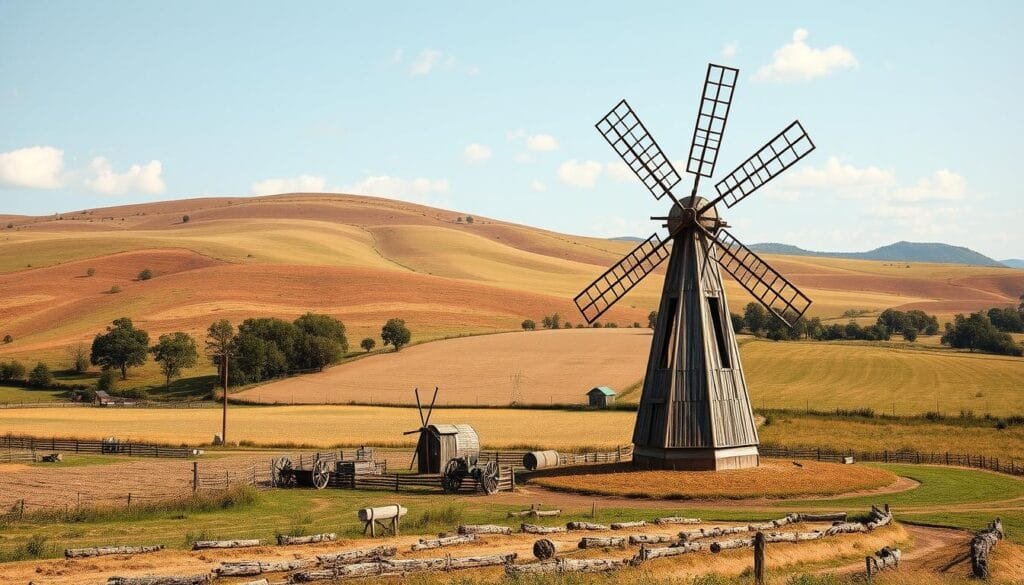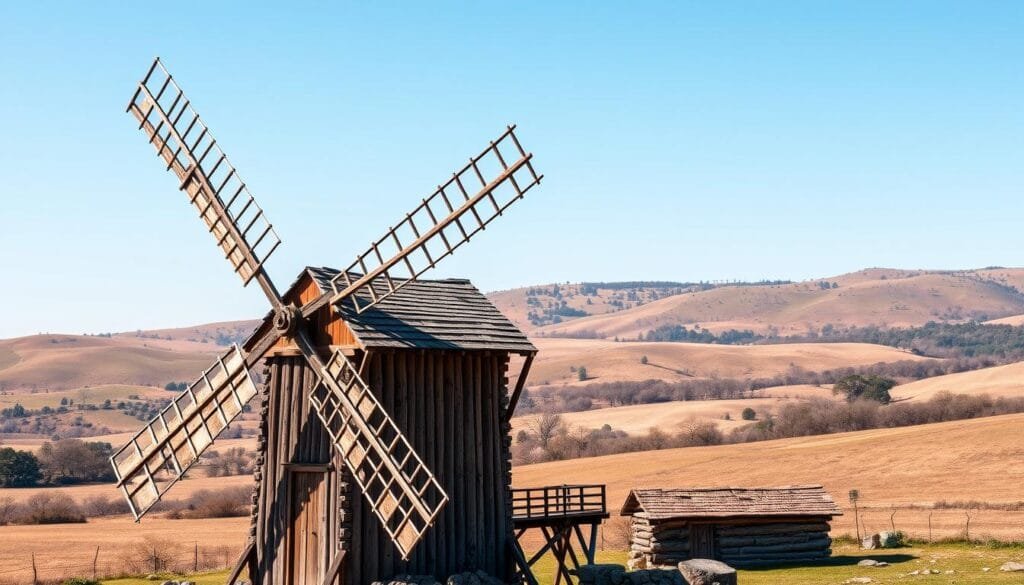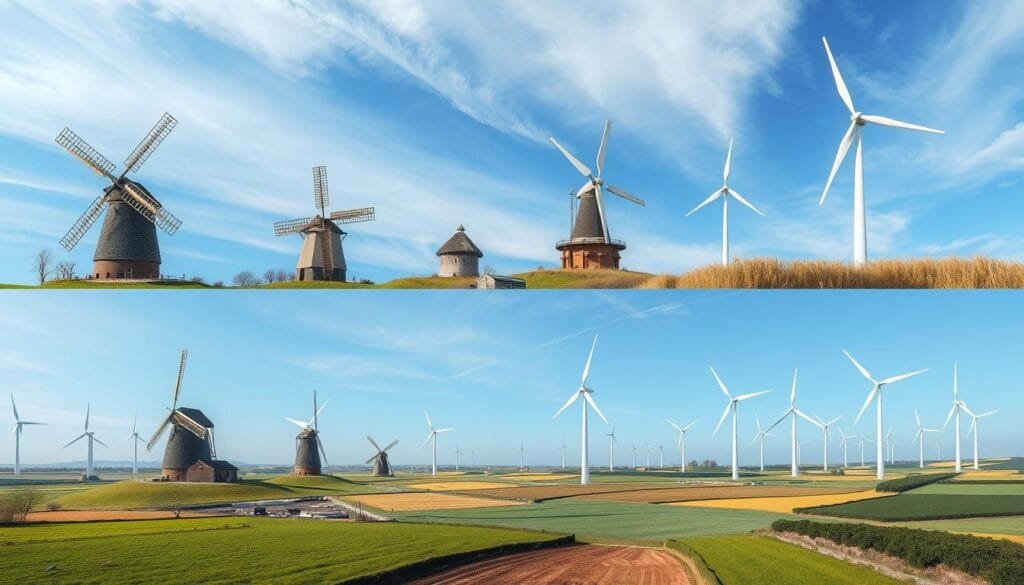Did you know the first electricity-generating wind turbine was built in 1887? This was a key moment in wind power history. Wind energy shows how humans have innovated, from simple sailing to complex machines.
The history of early wind turbines goes back thousands of years. It shows our clever ways to use wind power. From ancient times to today’s tech, wind energy has always been important.
When was the first wind turbine made? The first wind-powered tools were in the 1st century AD. But the big change came in late 19th century America. Charles F. Brush in Cleveland, Ohio, made a turbine with 144 blades and a 17-meter rotor.
Early wind turbines were used for grinding grain and pumping water. They also started to make electricity. These early designs helped create the advanced renewable energy systems we have now.
Key Takeaways
- First electricity-generating wind turbine built in 1887
- Charles F. Brush developed a groundbreaking wind turbine in Cleveland
- Wind power technologies evolved from mechanical to electrical generation
- Early windmills served agricultural and water pumping purposes
- Wind energy represents centuries of human technological innovation
Ancient Origins of Wind Power
Wind energy pioneers have a long history, going back thousands of years. They show how ancient people used wind power for many things. This shows our clever use of nature’s forces.
The first use of wind energy was in 644 AD in Persia. This was a big step in using wind technology. Ancient people found smart ways to use wind for moving things, watering crops, and doing work.
Early Maritime Wind Applications
Sailing ships were a key early use of wind power. Archaeologists found signs of wind-powered boats 5,500 years ago. This changed trade and exploration a lot.
- Sailboats enabled long-distance maritime trade
- Wind-driven vessels connected distant civilizations
- Advanced navigation techniques emerged from wind technology
Wind Power in Ancient Civilizations
Ancient windmills were very important in many societies. The Babylonian emperor Hammurabi wanted to use wind for irrigation in the 17th century BC. This showed early engineering skills.
“Wind is the breath of technological innovation” – Ancient Engineering Wisdom
Primitive Wind-Powered Mechanisms
Early wind-powered tools showed a lot of creativity. These early ideas helped start the path to today’s green energy.
| Civilization | Wind Technology | Purpose |
|---|---|---|
| Mesopotamia | Wind Irrigation Systems | Agricultural Water Management |
| Persia | Wind-Powered Grain Mills | Food Production |
| China | Wind-Powered Pumps | Water Transportation |
These early ideas show our long connection with wind energy. They helped start the path to today’s green technology.
Evolution of Windmills in the Middle East
The Middle East’s wind power history is a key part of wind technology’s origins. In the 8th and 9th centuries, ancient windmills were invented in places like Iran, Afghanistan, and Pakistan. They changed how people farmed and worked.
The asbad windmills of Iran show the region’s tech skills. These tall structures, up to 20 meters high, were like two-story buildings. They were built with amazing engineering.
- Vertical axle design with six to eight wooden sails
- Could process over 100 kg of wheat per session
- Were built to catch strong winds
“The winds of Sistan could blow up to 100 km/h, lasting an incredible 120 days from May to September” – Wind Technology Historians
The windmills’ design shows their advanced technology. In Nashtifan, for example, there are about 30 windmills. Five of them are working, showing the lasting impact of this old tech.
| Windmill Characteristic | Specification |
|---|---|
| Height | 20 meters |
| Sail Configuration | 6-8 wooden sails on vertical axle |
| Wheat Processing Capacity | Over 100 kg per session |
| Cultural Recognition | Recognized as cultural heritage in 2002 |
By 1991, these windmills had made a big difference in the area. They showed the cleverness of the first wind tech inventors.
The Birth of European Windmill Technology
The journey of wind energy pioneers started in medieval Europe. It changed how people used wind power. Early European windmills were a big step forward in technology, moving from old wind-powered tools to new engineering ideas.
European windmill technology showed great creativity in the 12th century. The first windmill was mentioned in 1185 in Weedley, Yorkshire. This was the beginning of a long journey in making early wind turbines.
Medieval Wind Power Innovation
Medieval engineers made big changes in using wind energy. They introduced:
- Changing from vertical to horizontal-axis windmill designs
- Creating more efficient sail and blade shapes
- Using windmills for more than just grinding grain
Dutch Windmill Revolution
The Netherlands was at the heart of windmill technology, making huge leaps in wind power use. By the late 1200s, Dutch windmills were everywhere, helping with many industrial tasks.
| Dutch Windmill Applications | Purpose |
|---|---|
| Land Reclamation | Draining Rhine River delta regions |
| Industrial Tasks | Grinding, sawing, pulverizing, pressing |
| Water Management | Pumping and lifting water |
Technical Advancements in Design
Wind turbine pioneers kept making windmill technology better. The automatic fantail, created in 1745, was a big step. It had 5-8 small vanes to adjust the mill sails for the best wind direction.
“The Dutch windmill design basics remain foundational to modern wind turbines, demonstrating over 700 years of technological evolution.”
These changes paved the way for future wind energy progress. They changed how we use renewable energy.
When Was the First Wind Turbine Made

In 1883, a major breakthrough happened at the Vienna International Electrical Exhibition. The first electricity-generating wind turbine was unveiled. This event was a turning point in renewable energy history.
For decades, inventors had been working on using wind to make electricity. Michael Faraday’s electric generator from 1831 was a key starting point. By the 1880s, scientists were focused on making wind power work for electricity.
“Innovation distinguishes between a leader and a follower” – Wind energy visionaries understood this principle deeply.
Important steps in the development of the first wind turbines include:
- 1883: Josef Friedländer’s electricity-generating wind turbine at Vienna Exhibition
- 1887: James Blyth creates first wind turbine for electricity production
- 1888: Charles F. Brush develops a significant wind turbine design
| Year | Inventor | Wind Turbine Achievement |
|---|---|---|
| 1883 | Josef Friedländer | First electricity-generating wind turbine |
| 1887 | James Blyth | First wind turbine for home electricity |
| 1888 | Charles F. Brush | Large-scale wind turbine with 17-meter rotor |
These early innovators changed how we see renewable energy. Their work led to today’s wind turbine technology. They set the stage for a greener energy future.
James Blyth’s Revolutionary Wind Generator
James Blyth made a big leap in wind energy in Scotland. He was one of the first to invent wind turbines. His work changed how we make electricity from wind.
Pioneering Electrical Generation
In July 1887, Prof James Blyth built a 10-meter high wind turbine in Glasgow. It was a big step for early wind turbines. His design was unique and different from old windmills.
- Location: Holiday cottage in Marykirk, Kincardineshire
- Height: 10 meters (33 feet)
- Sail Material: Cloth-based design
- Primary Purpose: Electricity generation
Technical Specifications of Blyth’s Innovative Design
Blyth’s wind generator was a big deal back then. He used Camille Alphonse Faure’s accumulators to store electricity. This let him light up his cottage with wind power, a first in history.
“The future of energy lies not in fossil fuels, but in harnessing the natural power around us.” – James Blyth (paraphrased)
| Feature | Specification |
|---|---|
| Turbine Height | 10 meters |
| Power Generation Method | Wind-driven electrical generation |
| Energy Storage | Camille Faure’s accumulators |
| Primary Application | Cottage lighting |
Blyth’s invention was a key moment in wind energy history. It showed wind power’s promise for electricity long before it was widely used.
Charles Brush’s Pioneering Wind Machine
Charles F. Brush was a key figure in the history of wind energy. He was born in Euclid, Ohio. His work on early wind turbines was groundbreaking.
Brush built his wind turbine in Cleveland during the winter of 1887-1888. It was a major step forward for wind turbine inventors. The machine had:
- Massive 17-meter diameter rotor
- 18-meter tall tower
- 12 kW power generation capacity
- Automatic operation capabilities
This wind machine ran from 1886 to 1900. It powered Brush’s home and lab, showing great reliability.
“The future of energy lies in harnessing natural forces with intelligent design” – Charles F. Brush
| Technical Specification | Details |
|---|---|
| Rotor Diameter | 17 meters (56 feet) |
| Tower Height | 18 meters (59 feet) |
| Power Output | 12 kW |
| Operation Period | 1886-1900 |
Brush’s turbine was a big step in wind power history. It showed the power of wind energy long before it was widely used. His work helped pave the way for today’s renewable energy.
Josef Friedländer’s Contribution to Wind Power
The late 19th century saw a big change in how electricity was made. Josef Friedländer was a key player in this change. He showed off a new wind turbine at the Vienna International Electrical Exhibition in 1883.
Friedländer’s turbine was a big step in electrical engineering. It had a 22-foot diameter and could power many electrical systems.
Vienna International Exhibition Impact
The exhibition was a big deal for Friedländer’s work. His turbine could power:
- 25 individual lamps
- Each lamp rated at 50 watts
- Total power output of 1.25 kilowatts
Technical Innovations of 1883
Friedländer’s system was full of advanced tech for its time. It had a centrifugal regulator that changed the electrical current based on wind speed.
“The wind turbine represents a revolutionary approach to electrical generation” – Contemporary Engineering Journal
| Feature | Specification |
|---|---|
| Turbine Diameter | 22 feet (6.6 meters) |
| Power Output | 1.25 kilowatts |
| Control Mechanism | Centrifugal Regulator |
Even with battery storage issues, Friedländer’s work was a big step forward. It inspired others to keep working on renewable energy.
The Halladay Windmill Innovation
The Halladay Windmill is a key part of wind power history. It was created by Daniel Halladay and supported by John Burnham. This design changed wind energy technology in the mid-1800s.

This windmill brought new tech that changed how we use wind energy. It had features like:
- Automatic wind direction adjustment
- Self-regulating sail pitch mechanism
- Consistent operational performance
In 1854, Halladay’s windmill showed it could run for six months without help.
The Halladay Windmill’s specs showed it was very capable:
| Performance Metric | Specification |
|---|---|
| Minimum Operational Wind Speed | 11 kph (6.7 mph) |
| Water Pumping Depth | 8.5 m (28 ft.) well |
| Water Lift Height | 30 m (98 ft.) |
The U.S. Wind Engine & Pump Company grew from this innovation. By 1872, using steel made the windmill even better. This was a big step forward in wind energy.
Early Commercial Wind Power Applications
The Industrial Revolution was a key moment in wind power history. It turned wind energy into a complex commercial technology. Wind power became a vital energy source in many industries, like agriculture and manufacturing.
In the mid-19th century, wind energy made big strides. Over 1 million wind-powered water pumps were used in the American Midwest and West. They helped solve water supply problems for growing farms.
Industrial Revolution Integration
During this time, wind power firsts changed industrial processes. The classic American windmill became a key player. It helped with:
- Water pumping for farms
- Power for small factories
- Grain milling in remote areas
Agricultural Uses and Expansion
Wind-powered generators showed their flexibility. They worked on different scales:
| Application Scale | Power Output | Primary Use |
|---|---|---|
| Small Residential | 12 kW | Battery Charging |
| Agricultural | 30-50 kW | Water Pumping |
| Industrial | 100+ kW | Mechanical Power |
The Halladay Windmill, from the 1850s, was a major breakthrough. It had a 10-foot diameter and could lift water 28 feet. This greatly improved farm productivity in frontier areas.
Wind power went from being an experimental idea to a practical solution. It changed the economic scene in rural America.
Transition to Modern Wind Turbines
The history of wind turbines is exciting. It shows how they changed from simple machines to complex electrical devices. As electricity became common, wind power found new uses.

In the early 20th century, important milestones happened. There were two main paths:
- Small wind plants for farms and homes
- Big wind generators for the power grid
Big changes came with new technology. Materials science, better aerodynamics, and new electrical systems made wind power useful. It went from a test idea to a real energy source.
“The future of energy lies in harnessing the power of wind with increasing efficiency and innovation.” – Wind Energy Pioneer
| Decade | Key Development | Power Output |
|---|---|---|
| 1880s | First Electricity-Producing Turbines | 12 kW |
| 1950s | Danish 200-kW Turbine | 200 kW |
| 1970s | Mod-Series Wind Turbine Program | 100 kW – Multi-MW |
This change was driven by a growing need for clean energy. Wind turbines became key players in the fight against climate change. They went from being oddities to essential parts of our energy mix.
1970s Energy Crisis and Wind Power Revival
The 1970s were a turning point for wind power, changing the face of renewable energy. The global oil crisis made people look for new energy sources, like wind. This time was key for wind energy, changing how we think about power.
Government Initiatives Driving Wind Turbine Innovation
Governments around the world started programs to boost wind turbine tech. The U.S. and Denmark led this green energy shift. They focused on:
- Offering big tax breaks for wind energy projects
- Granting money for research and development
- Creating policies that support green energy
Technological Breakthroughs in Wind Power
Between 1981 and 1984, wind energy saw a huge leap forward. California put up 6,870 wind turbines, thanks to government support and a 25% tax credit. This was a major step forward in wind turbine history.
“The energy crisis was not just a challenge, but an opportunity to reimagine our power infrastructure.” – Renewable Energy Expert
By 2008, the U.S. had a big win, hitting 25,170 MW of wind power. This was about 1% of the country’s energy use. It showed wind power’s big promise as a fossil fuel alternative.
This wind energy comeback set the stage for today’s strong renewable energy scene. It showed that innovation can come from tough times.
First Wind Farms and Commercial Success
The growth of wind power hit a major milestone with the start of the first commercial wind farms. In December 1980, a key moment happened in New Hampshire. U.S. Windpower set up the world’s first wind farm there. It had 20 turbines, each making 30 kilowatts, a big step in wind energy history.
Soon, wind farms started popping up around the world. The UK saw its first commercial wind farm in November 1991 at Delabole. It had 10 advanced turbines. Denmark then built the world’s first offshore wind farm, Vindeby, in the same year. It had 11 turbines, each with a power of 450kW.
| Wind Farm Location | Year Established | Turbine Count | Capacity |
|---|---|---|---|
| New Hampshire, USA | 1980 | 20 | 0.6 MW |
| Delabole, UK | 1991 | 10 | 4.5 MW |
| Vindeby, Denmark | 1991 | 11 | 4.95 MW |
Wind farms grew fast around the world in the following years. China became a big player, aiming for a huge 20,000 MW capacity by 2020. By 2012, they had over 6,000 MW, showing how fast wind energy was improving.
- Largest onshore wind farm: Gansu Wind Farm (China) – 8,000 MW
- Largest offshore wind farm: Hornsea Wind Farm (UK) – 1,218 MW
- First commercial wind farm: Delabole (UK) – 1991
“Wind farms represent not just an energy solution, but a testament to human innovation in renewable technology.” – Anonymous Energy Expert
These early wind farms changed the world’s energy scene. They showed that wind power could be a real and big alternative to old energy sources. From small tests to huge projects, wind farms keep pushing us towards a greener future.
Conclusion
The history of wind power is a story of human creativity and progress. It has evolved from simple machines to advanced energy systems. Key milestones show how technology has changed our way of making renewable energy.
From the first wind turbine in 1887 to today’s big offshore farms, we’ve made huge strides. Modern turbines work well in many places, from homes to huge farms. They are designed to be efficient, working best at 18-27 mph winds.
Design improvements have made turbines more powerful, making wind energy a strong alternative to fossil fuels. Research keeps going, tackling issues like environmental effects and tech limits. Early worries about birds have been solved, and new patents by Siemens and GE show the field is always evolving.
Wind energy is a symbol of human creativity and our goal for clean energy. It shows how far we’ve come from the first 10-meter-high turbine. This journey highlights the power of sustainable innovation.














